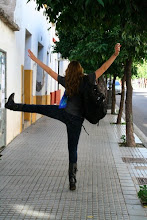In the final segment of CADS, it was nearly impossible to avoid the idea of regression and repetition. It becomes a theme that is more and more prominent as the book progresses. After the massacre of the 3,000 plantation workers, José Arcadio Segundo retreats to his own solitude in Melquiades’s room, just as Colonel Aureliano Buendía did after his experiences in the war. The Buendía house as well as the rest of Macondo is ruined by the rain, bringing them back to square one in some respects:
Macondo estaba en ruinas. En los pantanos de los calles quedaban muebles despedazados, esqueletos de animales cubiertos de lirios colorados, ultimo’s recuerdos de las hordas de advenedizos que se fugaron de Macondo tan atolondradamente como habían llegado…La región encantada que exploró José Arcadio Buendía en los tiempos de la fundación, y donde luego prosperaron las plantaciones de banano, era un tremedal de cepas putrefactas, en cuyo horizonte remoto se alcanzó a ver por varios años la espuma silenciosa del mar (450).
The death of Ursula is portrayed to be a regression biologically, first, in the way that she slowly loses her mind and awareness and secondly in her physical appearance which is likened to that of a fetus:
Poco a poco se fue reduciendo, fetizándose, momificándose en vida, hasta el punto de que en sus últimos meses era una ciruela pasa perdida dentro del camisón, y el brazo siempre alzado terminó por parecer la pata de una marimonda (463).
Rebeca is described similarly upon her death: bald, looking shrimp-like. Not long thereafter, Aureliano Segundo and José Arcadio Segundo pass away, and are confused once again as they were at birth when the family places one’s body in the other’s grave.
GGM brings out an obvious feeling of repetition that fades into digression as the family repeats and recycles the same fate and the remaining members die or separate from the family. With the return of José Arcadio and Amaranta Úrsula to Macondo, a false sense of hope is brought to the surface and quickly put out by the repetition of the same acts/desires/interests as their ancestors. It is interesting, because as the return of José Arcadio is described and he resumes his everyday life again in Macondo, the echoes of all of the Buendía family are reflected in all of his actions (see p. 492-494), from the room that he chooses to stay in to the way that he bathes, etc. This idea is perpetuated constantly throughout the rest of the book up until the death of Amaranta Úrsula and their child with the pig’s tail (as promised and well-anticipated) all the way to the final words of CADS which mirror themselves and fold the story inside out to close the circuit of the Buendía family (and all of humanity?).

I really like how you gave examples of the regression in time, because we had talked about the fact that the events or time is cyclical in this book, however the idea of regression had not occured to me. The description of Ursula's situation that you gave seems like the best examples that demonstrates this phenomenon.
ReplyDeleteHeh, I like the image of a "moving standstill." In some ways that captures the final scene rather well: Aureliano is standing still, reading, in the center of the house while everything else whirls around him.
ReplyDelete